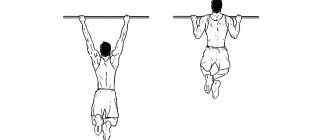Hello, dear readers!
In this article, I will tell you about a great way to create a beautiful and toned figure - this is a workout program for 5 days a week! It is designed for well-trained sports fans who have already built up muscles and want to look lean. This program is designed to gain muscle mass and definition.
We recommend reading: How m grow; muscles: short guide
Muscles grow as strength increases and strength endurance increases. By conducting separate training for each large muscle group, you can accustom it to a large volume of training load, which will result in muscle growth. In addition, by training 5 times a week you will speed up your metabolism very well. And if you endure a couple of months of working on it, you will acquire excellent relief.
Surely many of you have used three-day splits in your training process. Increasing the frequency of training to five per week gives you a significant advantage - every day you can train one muscle group per workout.
Let's look at a specific example of a training program designed for 5 days a week, which, if necessary, you can adjust to suit you.
Principles of a Mass Gaining Training Program
Gaining muscle mass is the main goal of men who come to the gym. Achievement depends on these factors:
How much to train
The duration of a gym session should not exceed 1 hour. Stay busy longer and you will become overworked and start to burn your muscles. The pause between approaches should last from 1 to 4 minutes, this is enough for recovery. Very long periods of rest can affect the effectiveness of the exercise - the muscles return to their original state before exercise.
How often should you exercise to grow muscles?
There are certain requirements for the rest period between workouts for certain muscle groups - at least 72 hours. Hence the recommended frequency of training is no more than four per week: 3 strength and 1 light recovery.
With each workout, muscle fibers are broken down, vital nutrients are depleted and, of course, fatigue. This results in decreased functionality. From this starting point, your body will repair itself by increasing muscle protein synthesis to repair muscle tissue, returning you to baseline as quickly as possible. If recovery is normal, there is a period of supercompensation during which your functionality exceeds your baseline level. This means that your muscles are growing faster than before.
Basic training
Do you want to become huge? Do a basic training program to gain weight. It is on this basis that you will build bulky muscles so that you can subsequently transform them into relief during training.
“Compound” exercises are called multi-component exercises that train several muscle groups at the same time, while isolation exercises work only one. Start the first training phase (1-3 weeks) with the core exercises - deadlifts, squats and bench press - and then continue with the formation of individual muscle groups in the second phase (4-6 weeks). The program is divided into:
- increasing the volume of the biceps;
- pumping the legs;
- building shoulder muscles;
- back pumping.
At the third stage of gaining muscle mass (7-9 weeks), you can additionally begin detailed work on the trapezius, triceps, forearms and other smaller muscles
Reps and sets for bulking
The optimal range of repetitions of one exercise in a set is 6-12, all approaches should be no more than three. Work in a relaxed manner, focusing on the correct technique. Training to gain muscle mass requires a thoughtful and thorough approach, and neglecting the technique leaves its mark on the speed of achieving results and its quality. Moreover, these are not only the mistakes of beginners, but also of some experienced bodybuilders. Be smarter and work solely for the sake of results.
Free weights
An effective weight training program should definitely include free weights, since it is resistance exercise—with barbells and dumbbells—that promotes active muscle growth. Just don't let your muscles get used to a certain weight, otherwise they will stop growing. Increase your working weight, but remember: you must do it gradually.
Muscle shocking
Make changes to your program every 3-4 weeks so that your muscles don't have time to adapt and become stressed by the unusual workload. You can increase the intensity of your classes, add new exercises, increase the load, etc. Constantly expand your knowledge about methods of influencing the body and pump up your muscles.
Recovery and muscle gain
It may surprise you, but muscle fiber growth occurs not during exercise, but during rest. This means that high-quality muscle hypertrophy can only be achieved by following a recovery regimen. Proper muscle recovery after training is one of the keys to success in your chosen goal.
Protect your muscles from overexertion and give them time to recover. The ideal option is to choose a program that uses one muscle group no more than once a week. This way you gradually work your whole body without overloading.
The key to high-quality weight gain is a training program that is chosen wisely and takes into account the characteristics of your body.
The recommended strength training program is suitable for intermediate to advanced bodybuilders. The training plan is designed for 6-8 weeks.
Options for complexes for men
Five-day training can be used to increase muscle mass, create relief, increase strength and endurance. To choose the appropriate complex, the athlete must first decide on the goal. Only after this can he create a program or select the most suitable scheme from those presented on the Internet.
The main thing is to correctly distribute the load on different muscle groups throughout the day. You cannot train the same group for several days in a row. For example, work on the back muscles after loading the biceps or training the chest after the triceps.
An athlete can train for 5 days in a row and then rest for 2 days. You can also arrange training days with a break of 1-2 days. When choosing a program, consider your own recovery capabilities, lifestyle, etc. The main thing is that the interval between classes does not exceed a week, otherwise you will miss the moment when the muscles have almost completely recovered, slightly increased and strengthened.
There are many split options, an athlete can load the leg muscles on the first day, the chest on the second, the back on the third, the deltoids on the fourth, the arms on the fifth, and then rest for 2 days. You can also use this option: the first day - back, the second - chest, the third - legs, the fourth - deltoids, the fifth - arms, and then 48 hours of rest. The exercises are repeated 8-10 times three or four times with no more than 2 minutes of rest between approaches.
The program lasts from 8 to 12 weeks, after which you need to change the complex.
There is an effective five-day program for gaining muscle mass:
- Leg training – hyperextension, weighted squats, deadlifts.
- Loading the biceps, triceps - barbell biceps press, pull-ups, arm extension on the block.
- Working out the back and pectoral muscles - lying down, rowing, crossover, pull-ups.
- Pumping the shoulders, abdomen - lifting the barbell above your head, rowing to the chin, dumbbell flyes, raising your arms from the lower block, crunching on a Roman chair.
- Legs – reverse hyperextension, deadlift, machine leg raises, reverse hack squats.
You can use other exercises or add new elements to the complex.
Important! The muscles of the legs are loaded twice a week, the first time working on large muscle groups, and the second time on small ones. The arms are pumped in front of the chest and back so that the muscles of the upper limbs do not take part of the load on themselves.
The weight of the projectiles must be selected so that you can do 8-12 repetitions with them with effort. Exercises are performed in 4-5 sets. Before the complex there is a warm-up (running, jumping rope). The workout lasts up to 60 minutes.
When working on relief, the athlete must train in a high-repetition mode. We can say that this is cardio training with elements of strength training.
The complex can be built in this way:
- The legs and muscle corset are loaded with the help of hyperextensions, bench press, extension, bending in the simulator, twisting, etc.
- To pump up the chest and biceps, do bench presses, abductions, and arm curls in the machine.
- A dumbbell press, arm raises in a machine, Smith squats, and lunges with an apparatus will help load your legs and shoulders.
- The back and trapezius are developed with pull-downs, arm extensions, and pull-ups.
- For the delta, the abdominal muscles perform crunches, leg raises, bench presses, and dumbbell swings.
This scheme helps to load each muscle structure 2 times a week.
The training follows the principle of a superset: after completing one exercise, the athlete immediately moves on to another, and then rests. The pause between sets does not exceed 1 minute. You need to do 4-5 supersets of double exercises. The number of repetitions increases to 15-25.
Important! If you have a tendency to be overweight, then day 6 should be devoted to long-term cardio exercises - 40 minutes or more.
To increase strength, you need to train for at least 4-8 weeks.
Example of a program for developing strength:
- The first day is devoted to the back muscles - various types of traction in the simulator.
- On the second, the legs are loaded - squats with weights, extension, flexion in the simulator.
- This is followed by rest, since the first 2 days are quite difficult.
- On the fourth day, the chest works, the shoulders do presses, swings with apparatus.
- The fifth day is devoted to the arms and abs - lifting equipment, flexion, extension in a block, twisting, hanging leg raises.
Then follow 2 days of rest.
The main feature of the program for increasing strength is that before and after performing the complex, cardio training is performed, which accelerates muscle growth. The movements are performed 8-12 times three or four times. Cardio exercise is given for 5-15 minutes.
Warm-up
Training program for 5 days:
- Stand up straight, tilt your head forward, backward, right, left, and then rotate your head in a circle. Do 5-10 tilts and 10 rotations.
- Rotate back and forth in a circle, first with one hand, then with the other, and finally with both. Keep your arms straight. 10-15 times will be enough.
- Rotate your hands in a circle, first in one direction, then in the other, or clasp your hands together and do all of the above.
- Take an even stance and turn to the right 10 times and to the left the same number. This warms up the back muscles well. And then bend your torso forward, while stretching your arms towards the floor as much as possible.
- Pelvic rotation. Everything is clear here, this exercise also warms up your back, do 15 circular rotations in different directions.
- From a level stand, rise onto your toes and stretch your arms towards the sun, or towards the chandelier. Perform 20 of these lifts.
- Shift your weight onto one leg and rotate the other in clockwise and counterclockwise circles. Also perform 20 rotations with each leg.
- Jump in place 10 times, and then make the exercise more challenging by raising your knees toward your chest as you jump.
- Sit on the surface, straighten your legs and try to fold yourself like a book, reaching your hands towards your heels.
- Remaining in a sitting position, spread your legs to the sides and now stretch your chest towards the floor, hold for 30 seconds.
Cardio
Effective weight loss consists of healthy eating, not dieting, good sleep and exercise. For those who want to lose excess fat, cardio training is suitable. This is intense physical exercise that increases your heart rate. Such training develops the cardiovascular system, increases endurance and promotes weight loss.
Running, walking, dancing, swimming, cycling or jumping rope are all forms of cardio exercise. Choose what you like best, and doing it will only be a pleasure. You can plan your cardio training program for 5 days a week based on your abilities.
For beginners, walking or cycling is suitable. This is an excellent choice because it does not take much time, literally 30-40 minutes a day will be enough. This type of aerobic training is easy to fit into your usual regimen and five-day set of exercises. Simply replace the bus ride with a bike ride, or get off a few stops early and walk. Turn on the music, take your friends or your pets and enjoy a walk.
For those who are already a little physically fit, running or jumping rope would be a good option. Such loads should be performed on an empty stomach in the morning or evening. But it is important not to overdo it, you can alternate between calm running and acceleration and be sure to monitor your breathing. Things are the same with a jump rope, calculate your capabilities and enjoy the process. During training, imagine your desired result, this is really motivating.
There are also a large number of already compiled circuit training. You must do the exercises in a certain sequence and with time. Such training can last from 10 to 90 minutes. The most optimal option for a training program for 5 days a week is 10-30 minutes.
Multi-joint basic exercises
When performing multi-joint basic exercises with heavy weights, the athlete's entire body is subjected to stress. In addition to the muscles of the arms, body and legs, the respiratory and even the central nervous system are involved in the work - this is what provides a significant hormonal response, leading, ultimately, to muscle growth.
It should be noted that the greatest effectiveness for muscle growth is achieved with heavy strength training and performing a low number of repetitions of exercises - no more than 5-7 repetitions. This, in turn, requires not only the use of large working weights and perfect adherence to the correct technique, but also longer rest.
List of basic exercises
The compound exercises are five multi-joint exercises performed with a barbell: the bench press, the standing barbell press, the barbell squat, the bent-over row, and the deadlift. It is these strength exercises that most actively influence the growth of muscle mass and increase the hormonal levels of the body of even a novice athlete.
However, most of the secondary exercises performed with dumbbells or on machines are variations of the basic exercises. For example, a seated dumbbell press or a shoulder press in a machine is a modified standing barbell press. Just like the bench press, it's essentially a variation of push-ups. The only exception is pull-ups.
Deadlift
The deadlift is the number one core exercise for the core. If you do only this and give up any others, you will still see the result in the form of mass gain, since it is the deadlift that involves the maximum number of muscles in the work.
Squats
Barbell squats are a basic exercise for developing leg muscles, from the glutes and quadriceps to the calves. With the correct technique, the spine and abdominal muscles are also included in the work, forming a steel press.
Bench press
The bench press is a key exercise for developing the chest, triceps, and anterior deltoids. Depending on the angle of the bench and the width of the hands on the barbell, it is possible to include various bundles of the pectoral muscle in the work.
Barbell row to the waist
The barbell row is a basic exercise for developing the back muscles and giving it visual width. When performed correctly, the work also includes the deltoids, pectoral muscles, forearms and numerous arm holder muscles.
Standing barbell press
The standing barbell press (also called the “military press”) develops the shoulder girdle, deltoids, arms, improves posture and strengthens the abdominal muscles. It is this basic exercise that creates a classic athletic figure with broad shoulders.
Second workout: training your back
- Cardio: 5 minutes.
First superset:
- deadlift on straight legs: 3×10-15;
- hyperextension: 3×10-15.
- Cardio: 5 minutes.
Second superset:
- pull-ups on the horizontal bar to the chest: 3×8-15;
- horizontal pull of the block to the belt: 3×10-15.
- Cardio: 5 minutes.
Third superset:
- pull-down of the upper block to the chest with a parallel grip: 3×10-15;
- Bent-over dumbbell row: 3×10-15.
- Cardio: 5 minutes.
Rest between sets
The rest time between approaches is on average up to 2 minutes. You should always look at how you feel. When you have a surge of energy and the workout is going well, you can take fewer breaks. If you feel that it’s hard and you need more time to catch your breath and come to your senses, then rest more. But chatting on the phone and discussing who spent the evening with friends is not the best idea for a break between sets. The conversation is guaranteed to take more than 2 minutes – and you won’t even notice it. The effectiveness of training suffers both from insufficient rest and from too long breaks between approaches.
Fifth workout: train biceps and triceps
- Cardio: 5 minutes
First superset:
- Dips: 3×10-15;
- French bench press: 3×10-15.
- Cardio: 5 minutes.
Second superset:
- pull-ups on the horizontal bar to the chest with a reverse grip: 3×8-15;
- lifting dumbbells for biceps (hammer grip): 3×10-15.
- Cardio: 5 minutes
Third superset:
- standing biceps curl: 3×10-15;
- arm extension on the upper block: 3×10-15.
- Cardio: 5 minutes.
That's all. This is the training program. Yes, it's difficult, but it's worth it. I repeat once again: beginners don’t even need to look at this complex. And experienced guys will cope with such a load.
Good luck to everyone and success in working on this program. If you liked the program, like it and tell us about it on your page on social networks. From us - great gratitude and a plus for karma 
Number of approaches
I would like to warn you that you should limit your enthusiasm and not exceed the number of approaches in training. Before plunging into the harsh training process, you need to set the limits of the body's training capabilities, determine its individual characteristics, ability to recover from stress, as well as the training intensity necessary for muscle growth. Anything beyond these natural individual limits will lead to overtraining and stagnation.
When performing each approach, a certain amount of force is consumed, and the greater the number of approaches and repetitions, the greater the number. How much energy the body has left for muscle growth depends on its ability to recover
Therefore, it is important that you perform no more sets than the minimum required to stimulate muscle growth
Since we want to reduce the number of exercises required, it is logical to start our experiments with the smallest possible load - with one set. Minimum means, maximum results. And if it is possible to achieve an increase in strength and mass with a minimum of approaches, then this is good. To stimulate growth in muscle strength and size, no more than one approach is required for each exercise and more than two for each muscle group.
Use the pyramid principle with each set: start with low weights and high reps, then gradually increase the weight. At the same time, the number of repetitions that you can perform will decrease; the number of repetitions you can do will decrease. Their total number must correspond to the program recommendations.
The main recommendation for gradually increasing weights relates to warm-up. Start the exercise with 50% of your maximum weight. Do at least 3-4 warm-up approaches as you approach the working weight.
Brief description of the 5x5 program
The 5x5 program consists of two complex workouts:
- Workout A: Squats, bench press, bent-over rows
- Workout B: Squats, military press, deadlift
You train three times a week, alternating between workouts A and B, resting at least 1 day in between. Never train 2 days in a row as the body needs rest to get stronger.
Most people train on Monday, Wednesday and Friday. But you can do it on Tuesday, Thursday and Saturday or on Sunday, Tuesday and Thursday. If you work out 3 times a week and rest at least 1 day between 2 workouts, you will build strength.
When starting the 5x5 program, you will start with workout A, and after 2 days do workout B. So, in the first week you train according to the A/B/A scheme, in the second – B/A/B, in the third – A/B /A and so on.
The graph looks like this:
Week 1
| Monday | Wednesday | Friday |
| Squats 5x5 | Squats 5x5 | Squats 5x5 |
| Bench press 5x5 | Army press 5x5 | Bench press 5x5 |
| Bent-over barbell row 5x5 | Deadlift 1x5 | Bent-over barbell row 5x5 |
Week 2
| Monday | Wednesday | Friday |
| Squats 5x5 | Squats 5x5 | Squats 5x5 |
| Army press 5x5 | Bench press 5x5 | Army press 5x5 |
| Deadlift 1x5 | Bent-over barbell row 5x5 | Deadlift 1x5 |
Further, these programs are simply alternated. Everything is very simple.
All repetitions in all sets are performed with the same weight, not counting light warm-up sets.
Your goal is not to achieve a pump or muscle soreness (although this is possible after lifting heavy weights), but to increase the weight each workout. If you perform 5 reps on each set of an exercise, add 5 pounds to the bar next time. For 1x5 deadlifts, add 5kg each time.
Don't start lifting weights that are too heavy right away, or you'll experience pain that could cause you to skip a workout. Start with light weights so your body can adapt to the stress. Remember to add 2.5 kg per workout (30 kg per month) in squats.
If you're doing free weight exercises like squats, bench presses, and deadlifts without breaking form, start with a load equal to 50% of your 5RM. If you have never worked with free weights, haven’t trained for several years, or don’t know what 5RM is, then start with the following loads:
- Squats, bench press, military press: 20kg (empty Olympic bar).
- Deadlift: 40kg (empty Olympic bar + 2 10kg plates)
- Bent-over barbell row: 30kg (empty Olympic bar + 2 5kg plates)
You'll start with heavier weights on your deadlifts and bent-over rows because it's impossible to perform these exercises correctly with an empty bar. With each new repetition, the barbell should touch the floor.
Your first 2 weeks of training in the 5x5 program will look like this:
Week 1
| Monday | Wednesday | Friday |
| Squats 5x5 – 20 kg | Squats 5x5 – 22.5 kg | Squats 5x5 – 25 kg |
| Bench press 5x5 –20 kg | Military press 5x5 – 20 kg | Bench press 5x5 – 22.5 kg |
| Bent-over barbell row 5x5 – 30 kg | Deadlift 1x5 – 40 kg | Bent-over barbell row 5x5 – 32.5 kg |
Week 2
| Monday | Wednesday | Friday |
| Squats 5x5 – 27.5 kg | Squats 5x5 – 30 kg | Squats 5x5 – 32.5 kg |
| Military press 5x5 – 22.5 kg | Bench press 5x5 – 25 kg | Military press 5x5 – 25 kg |
| Deadlift 1x5 – 45 kg | Bent-over barbell row 5x5 – 35 kg | Deadlift 1x5 – 50 kg |
The deadlift uses more muscles than other exercises, so it will take you less time to progress. As soon as you reach 100 kg in working weight, add 2.5 kg to the bar with each workout.
If these weights seem light to you, remember that you will be adding 2.5 kg each workout. This means you will be squatting 50kg in 4 weeks, 80kg in 4 weeks and 100kg in 12 weeks! And all this in 5 sets of 5 repetitions! This weight is much more than most guys use in the gym. Overall, don't forget what's ahead of you.
You won't always gain weight. After a while, it will become difficult for you to complete 5 repetitions. You may not be able to follow the 5x5 protocol. Don't stop - just try again the next time you train. If this doesn't work, don't worry as there are many ways to overcome the plateau
The important thing now is that you just get started!
Principles of 5x5 training
1 The exercise system is quite simple: every week you increase the weight on the barbell.
2 In each workout, you will work your entire body - chest, legs and back.
3 Training frequency – 3 times a week (for example, Monday/Wednesday/Friday).
| # | Basic exercises of the 5x5 training complex |
| 1 | Back Squats |
| 2 | Deadlift |
| 3 | Bent-over barbell row |
| 4 | Bench press |
| 5 | Incline Barbell Press |
4 Number of repetitions – 5, number of approaches – 5. We calculate the working weight using the Excel table (later in the article we will explain how to use it).
Excel spreadsheet for determining working scales
5 The training program is not limited in time. The table contains calculations for 9 weeks to show how the working weight will increase. Then you can substitute new weights into the Initial values (those that you will have in the 9th week) - and the calculation for the next 9 weeks is ready.
You can train according to the 5x5 program for as long as progress is visible - an increase in strength and mass.
Champignons with potatoes in sour cream sauce
From the products for preparing this recipe you need to take:
- onion;
- 1 tbsp. l. flour;
- hard cheese;
- vegetable oil;
- salt;
- pepper;
- any spices, seasonings to taste.
Peel the potatoes and cook until tender. Divide large champignons into 4 parts, fry over medium heat until the moisture evaporates, then add salt, spices, and onion. As soon as it becomes a little softer, add sour cream and mix. Dilute a spoonful of flour in half a glass of water until the lumps disappear and pour the mixture into the frying pan. Next, cover it with a lid and stir occasionally, making sure that the mass is of medium thickness. If necessary, you can add water. Then add grated cheese to this mixture and mix again. Drain the water from the pan with the cooked potatoes and place the mushroom sauce on top.
Leave on low heat for 2-3 minutes
Important! If the time of year allows, you need to use young potato tubers
Basic principles of gaining muscle mass
Before drawing up a program and starting to perform exercises for mesomorphs, ectomorphs and endomorphs, you should familiarize yourself with the following principles of gaining muscle mass:
All loads should be progressive in nature - this is the basic principle, without which it is impossible to gain muscle mass, especially for a thin person
The process of adaptation to loads is a stimulating factor for muscle growth, so a weekly increase in intensity during training according to the developed programs will constantly improve the results achieved.
All exercises within the program should be performed in several approaches, which helps to work each muscle separately and stimulates their maximum development.
It is important to change not only the number of approaches and repetitions, but also the exercises themselves, aimed at different muscle groups. This prevents the body from getting used to the monotony of the training process, and muscle mass will continue to grow.
Searching for the most problematic areas of the body and local impact on them; to achieve this goal, isolation exercises should be performed. Particular attention is paid to this principle when working with the biceps, lower leg and other small muscles.
A gradual increase in weight in each approach when performing exercises using barbells, dumbbells and other sports equipment, as well as monthly training during which work with maximum weight is carried out
Such exercises should not be carried out systematically, since overtraining will give a negative result.
By designing a program in such a way that at the initial stage exercises are performed aimed at the most problematic areas of the body. This allows you to work them out with a maximum supply of energy, which makes the exercise more productive.
Additional work on the most complex muscles during intermediate approaches between the main sets, since in this case these groups will be subjected to not only the main, but also an additional load.
Providing static tension to the muscle group working during a specific exercise. This principle allows you not only to increase the volume of the muscle, but also to make its relief more attractive and improve separation.
Periodic performance of supersests, the essence of which is the sequential repetition of exercises that provide a load on the antagonist muscles, without making pauses between them. This principle is much more effective than training according to the traditional scheme with breaks between approaches. An alternative is the principle of combining sets: in this case, several different exercises are performed in a row, aimed at one muscle group, and a pause between them is also eliminated.
Providing maximum tension to the working muscle or muscle group in a state of peak contraction. This principle can be abandoned when performing exercises on blocks, since they maintain an even load throughout the body; in other cases, it allows you to maintain the achieved tension at a certain point until returning to the starting position.
The principle of incomplete amplitude is to perform several incomplete repetitions at the end of each approach. Compliance with this rule contributes to the retention of lactic acid in the muscle, as evidenced by the resulting burning sensation.
Incorporating forced reps is a complex principle that will require a partner to perform; it should not be practiced too often, so as not to provoke overtraining, which will give a negative result when gaining muscle mass. Its essence lies in the help of a partner to perform several additional repetitions of an exercise beyond the norm if one’s own reserve of strength has been completely used up.
There is the Blitz principle, which involves the use of all the principles outlined above. This training program is characterized by increased loads; it is recommended to practice it only for professional athletes or people who have been training for a long time and have good physical shape and endurance.
Programs to increase working weight
In “natural” training, i.e. without the use of pharmacological drugs, the redistribution of muscle mass depends on the strength of the osseous-ligamentous apparatus. The thicker and stronger the ligaments, the more muscle mass the body will allow itself to build.
The strength of the ligaments depends on the need for it, i.e. depending on how large the training weight is.
High-threshold fast muscle fibers, which are trained exclusively by strength training, in the repetition range from 1 to 5 with heavy weights, are responsible for the implementation of muscle contraction in a short period of time with maximum effort.
Let's look at several training programs that will help increase working weight in basic exercises.
Program for increasing working weight in the bench press
To increase the working weight in the bench press, you need to perform this movement in every workout, the same goes for all other exercises. At the same time, the specifics of performing the bench press will be radically different.
Let's consider in detail:
| Exercises | Approaches x number of times |
| Bench press | 5 x 8 |
| Bench press | 10 x 15 |
| Bench press | 3 x 3 |
| Bench press | 2 x 12 |
| Bench press | 3 x 6 |
| Bench press | 4 x 15 |
| Bench press with pause | 5 x 5 |
| Bench press | 4 x 15 |
| Bench press | 2 x 2 |
| Bench press with pause | 3x10 |
| Bench press | 4 x 12 |
| Bench press | 4 x 2 |
| Bench press | 4 x 15 |
| Bench press | 4 x 20 |
In this case, microperiodization is used, which has a beneficial effect on the development of the nervous system and an increase in strength indicators in this exercise. The numbers indicate the workouts themselves, which are performed after 1-3 days; they can be combined with training for other muscle groups.
Program for increasing working weight in deadlift
Deadlifts and squats with a barbell are similar exercises, so programs for increasing working weight in these movements will be similar:
| Exercises | Approaches x number of times |
| Deadlift | 3 x 12 |
| Squats | 4 x 6 |
| Deadlift from the pit 40% of maximum | 4 x 10 |
| Deadlift 60% of maximum | 5 x 12 |
| Deadlift from plates 100% of maximum | 3 x 6 |
| Barbell squats 60% | 4 x 10 |
| Deadlift 80% | 5 x 5 |
| Deadlift from the pit 30% | 10 x 10 |
| Deadlift 85% | 3 x 5 |
| Barbell squats 75% | 4 x 8 |
| Deadlift from the pit 40% | 10 x 10 |
| Deadlift penetration | Up to 1 rep with maximum weight |
Program for increasing working weight in squats
| Exercises | Approaches x number of times |
| Squats | 3 x 12 |
| Deadlift | 4 x 6 |
| Paused barbell squats with a weight of 40% of the maximum | 5 x 10 bent over barbell 3 x 12 |
| Front Squats | 3 x 10 Romanian deadlift 3 x 10 |
| Squats | 3 x 3 |
| Deadlift | 5 x 15 |
| Squats | 2 x 15 |
| Deadlift from plates | 3 x 3 |
| Squats | 4 x 8 |
| Front Squats | 5 x 3 Romanian deadlift 3 x 8 |
| Squats | 2 x 12, pit deadlift 2 x 10 |
| Squats | 6 x 6 |
| Deadlift | 6 x 6 |
| Paused barbell squats | 4 x 8 (40%) |
| Paused barbell squats | 1 x 10 (30%) |
| Squat walk | up to 1 repetition with maximum weight |
- The program should include training once every two weeks with a weight of 95% of the maximum and above.
- It is necessary to include light training to develop movement and train the central nervous system.
- It is necessary to add “auxiliary” exercises, such as “bench press with pause”, “squats with pause”, “deadlift from the pit”, “bench press from a bar (pressure)”, “half squat”, “deadlift from the block » - to overcome “dead zones” when driving.
- All approaches are not performed to failure. When performing an exercise, you should leave 1-2 repetitions in reserve in the case of training for a low number of repetitions, and about 5 repetitions when training for a high number of repetitions. This will help avoid central nervous system fatigue.
Mass training program
In order to get big quickly, it's important to focus your efforts on what really works - that is, a basic training program. In turn, a basic mass program is any gym program that involves performing multi-joint strength exercises with maximum weights, a limited number of approaches and a fairly low number of repetitions (from 3 to 6)
The basic training program described below is a barbell lifting program designed to increase strength. If muscle strength increases, then along with proper nutrition, the volume of muscle fiber will begin to increase. In other words, following a basic program and following a hypercaloric diet for muscle growth will help you get pumped up and bulk up quickly.
If you consistently follow the tips below, you can build 5-7 kg of quality muscle in the first 6-8 weeks of following a basic training program
However, it is extremely important to follow the basic rules of the program and train for hypertrophy (that is, completely abandon isolation exercises), and also pay special attention to your nutrition
What is a basic training program?
The basic training program is a mass-gaining program based on working all major muscle groups in one short workout. It is recommended to use multi-joint basic exercises as exercises - it is believed that they have the greatest effect on increasing hormonal levels and increasing the production of testosterone in the body. Which ultimately helps build muscles.
This program involves three short (no more than 45-50 minutes) but intense workouts per week, as well as enhanced nutrition (at least 3500-4000 kcal per day). Remember that high-calorie nutrition is the most important component of muscle pumping and growth - without additional calories, the body will not physically be able to build muscle, even when taking expensive sports nutrition.
How to plan your workouts for 5 days a week
Tips for beginners:
- You should decide on a goal, gain strength and motivation.
- Don't forget to warm up! After all, if you pull a muscle, you will have to take a break. It’s better to spend 10 minutes doing simple warm-up exercises.
- Make a schedule, it will make life much easier. For example, on Monday you do a workout for your back and arms, and on Tuesday you do a workout for your abs. And if you keep a personal diary where you will note all your successes, then this is doubly good.
- Try to train every other day, don’t bring yourself to the point of being a helpless wimp. Your muscles need rest too.
If you are still a beginner or new to this, it is better not to create a training program for 5 days a week yourself. It is important to correctly distribute the load.










